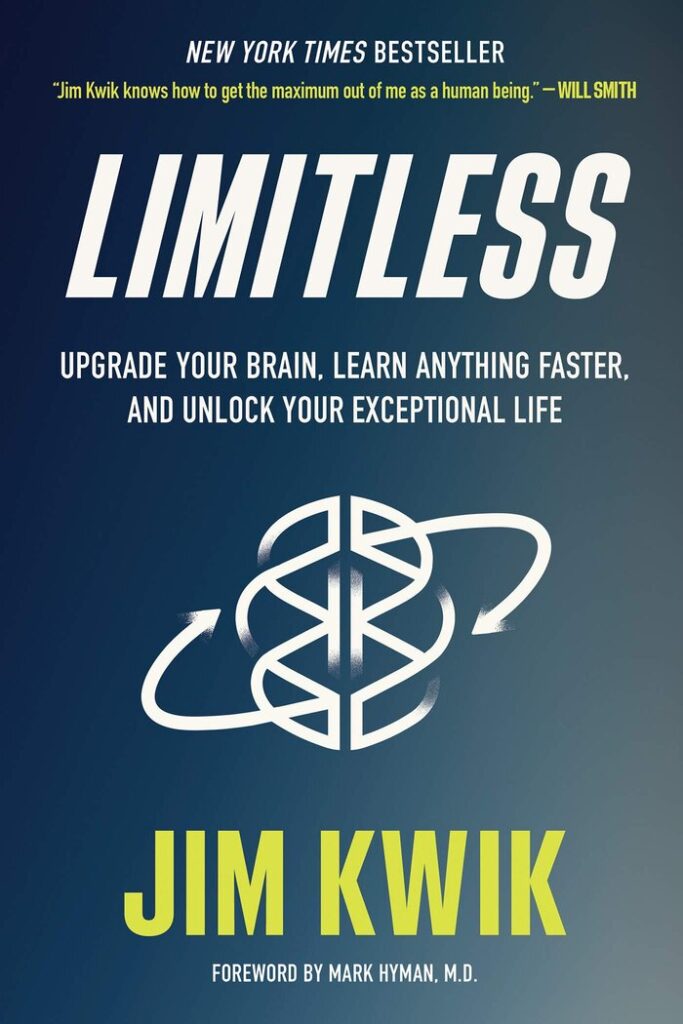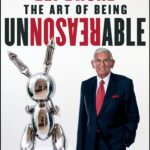In Limitless: Upgrade Your Brain, Learn Anything Faster, and Unlock Your Exceptional Life, brain coach Jim Kwik provides a road map to become limitless, indicting the four growing villains that are challenging our capacity to think, focus, learn, grow, and be fully human.
Limitless gives people the ability to accomplish more–more productivity, more transformation, more personal success and business achievement–by changing their Mindset, Motivation, and Methods.
Limitless is a blueprint for upgrading your brain, for not only learning how to learn faster, better, and more effectively, but also for healing your physical brain through nutrition, supplements, exercise, meditation, sleep, and more to increase the creation of new brain cells and the connections between them
Limitless Book Theme
You were born with the ultimate technology, and there is nothing more important than the health and fitness of our brain—it controls everything in life. Learning how to filter all the data, to develop new methods and skills for thriving in a distracted world drowning in a flood of information, is what is needed to thrive in the 21st century.
Learning and the ability to learn faster and more easily makes everything else in life possible, which means that it’s never been a better time to train your brain the way you do your body. Just like you want a healthy body, you want a flexible, strong, energized, and fit brain.
Limitless teaches five key methods to achieve whatever we want: Focus, Study, Memory Enhancement, Speed Reading, and Critical Thinking.
The Four Villians
Digital Deluge
The first is digital deluge—the unending flood of information in a world of finite time and unfair expectations that leads to overwhelm, anxiety, and sleeplessness. Drowning in data and rapid change, we long for strategies and tools to regain some semblance of productivity, performance, and peace of mind
Digital Distraction
The second villain is digital distraction. The fleeting ping of digital dopamine pleasure replaces our ability to sustain the attention necessary for deep relationship, deep learning, or deep work.
Digital Dementia
The next villain is digital dementia. Memory is a muscle that we have allowed to atrophy. While there are benefits to having a supercomputer in your pocket, think of it like an electric bicycle. It’s fun and easy but doesn’t get you in shape. Research on dementia proves that the greater our capacity to learn—the more mental “brainercise” we perform—the lower our risk of dementia. In many cases, we have outsourced our memory to our detriment.”
Digital Deduction
The last brain-damaging villain is digital deduction. In a world where information is abundantly accessible, we’ve perhaps gone too far in how we use that information, even getting to the point where we are letting technology do much of our critical thinking and reasoning for us. Online, there are so many conclusions being drawn by others that we have begun to surrender our own ability to draw conclusions. We would never let another person do our thinking for us, but we’ve gotten far too comfortable with letting devices have that very power.
The Secrets to a limitless life
- First, your purpose. The reason why matters.
- The second key is the ability to do what you want.
- The last key to being limitless is using the right method.
Unlimiting
The act or process of casting aside inaccurate and restrictive perceptions of one’s potential and embracing the reality that, with the right mindset, motivation, and methods, there are no limitations.
Becoming limitless is not just about accelerated learning, speed-reading, and having an incredible memory. Being limitless is not about being perfect. It’s about progressing beyond what you currently believe is possible. Just as you’ve learned limits from your family, culture, and life experiences, you can unlearn them. These constraints are only temporary obstacles that you can learn to overcome.
The Limitless Model: Mindset, Motivation and Method
- A limit in your Mindset—you entertain a low belief in yourself, your capabilities, what you deserve, or what is possible.
- A limit in your Motivation—you lack the drive, purpose, or energy to take action.
- A limit in your Methods—you were taught and are acting on a process that is not effective to create the results you desire.
- Mindset (the WHAT): deeply held beliefs, attitudes, and assumptions we create about who we are, how the world works, what we are capable of and deserve, and what is possible.
- Motivation (the WHY): the purpose one has for taking action. The energy required for someone to behave in a particular way.
- Method (the HOW): a specific process for accomplishing something, especially an orderly, logical, or systematic way of instruction.
The Limitless Brain
Generates up to 70,000 thoughts per day. It races with the speed of the fastest race car. Like your fingerprints, it is uniquely yours—there aren’t two brains in the universe exactly the same. It processes dramatically faster than any existing computer, and it has virtually infinite storage capacity. Even when damaged, it is capable of producing genius, and even if you only have half a brain, you can still be a fully functioning human being.
The Forgetting Curve
Psychologists refer to this as the “forgetting curve.” It is the mathematical formula that describes the rate at which information is forgotten after it is initially learned. Research suggests humans forget approximately 50 percent of what they learn within an hour, and an average of 70 percent within 24 hours.
The FASTER Method: The acronym FASTER stands for: Forget, Act, State, Teach, Enter, Review.
“F is for Forget”
The key to laser focus is to remove or forget that which distracts you. There are three things you want to forget (at least temporarily)
what you already know
The first is what you already know. When learning something new, we tend to assume we understand more than we do about that subject. What we think we know about the topic can stand in the way of our ability to absorb new information.
To learn beyond your present sense of restraints, temporarily suspend what you already know or think you know about the topic, and develop a beginner’s mind.
what’s not urgent or important.
The second thing is to forget what’s not urgent or important. Contrary to popular belief, your brain doesn’t multitask (more on this later). If you’re not fully present, it will be difficult for you to learn when your focus is split.
Limitations
And finally, forget about your limitations. These are the preconceived notions you believe about yourself, such as that your memory isn’t good or that you’re a slow learner. Suspend (at least temporarily) what you believe is possible.
Do your best to keep your self-talk positive. Remember this: If you fight for your limitations, you get to keep them. Your capabilities aren’t fixed, and it’s possible to learn anything.
A is for Act
Traditional education has trained many people that learning is a passive experience. You sit quietly in class, you don’t talk to your neighbor, and you consume the information. But learning is not. a spectator sport. The human brain does not learn as much by consumption as it does by creation.
S is for State
All learning is state-dependent. Your state is a current snapshot of your emotions. It is highly influenced by your thoughts (psychology) and the physical condition of your body (physiology). Your feelings or lack thereof about a subject in a specific situation affect the learning process and ultimately the results.
When you tie a feeling to information, the information becomes more memorable.
Information x emotion = long-term memories
T is for Teach
If you want to cut your learning curve dramatically, learn with the intention of teaching the information to someone else.
“Think about it: If you know you have to give a presentation on what you learn, you will approach how you learn the topic with the intention of mastering it well enough to explain it to someone else. You will pay closer attention. Your notes might be more detailed.”
“When you teach something, you get to learn it twice: once on your own, and then again through educating another person.”
E is for Enter
“What is the simplest and most powerful personal performance tool? Your calendar.”
We enter important things on our schedule: work meetings, parent-teacher gatherings, dentist appointments, taking Fluffy to the vet, and so on. Do you know what a lot of people don’t schedule? Their personal growth and development. If it’s not on your calendar, there’s a good chance it’s not getting done. It’s too easy for the day to slip by with you “forgetting” to work out your body and brain.
R is for Review
One of the best ways to reduce the effects of the forgetting curve is to actively recall what you learned with spaced repetition. You are better able to retain information by reviewing in multiple spread-out sessions. Going over the material at intervals increases our brain’s ability to remember it.
All the best in your quest to get better. Don’t Settle: Live with Passion.



Comments are closed.